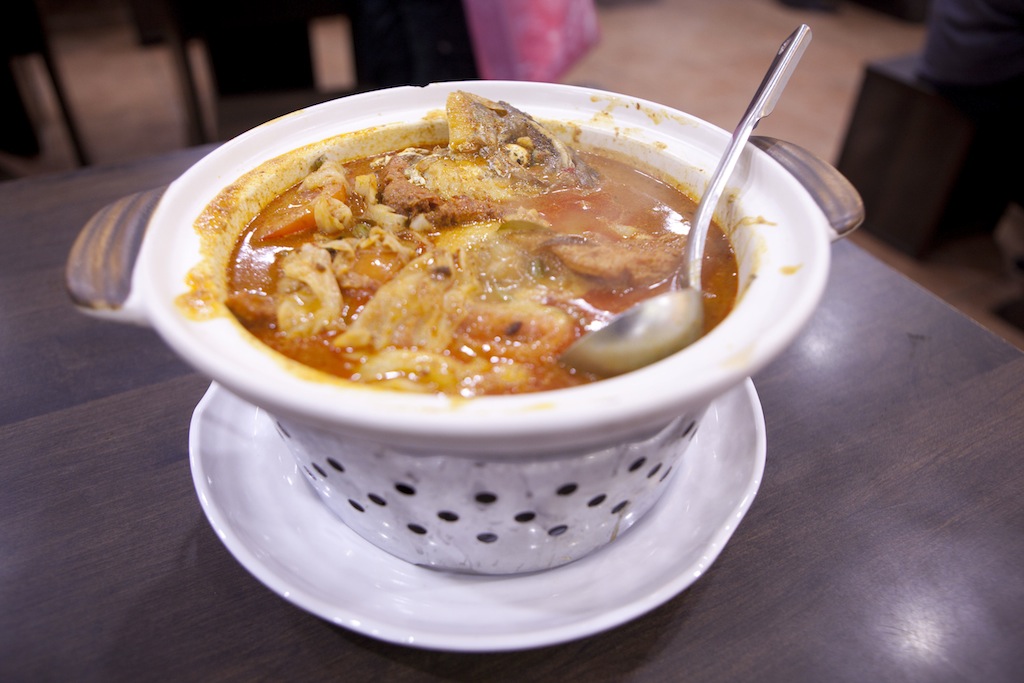The food: Asam Fish Head Curry
Where to find it: Xin Yuan Ji Pte Ltd Restaurant, Singapore
-:-
I’ve said it before, and I’ll say it again, Singapore embodies a melting pot of cultures. If I hop onto the subway anywhere in this harbor city, I’m bound to witness burqa-wearing Muslims packed together with smartphone-touting Taiwanese. I love this city.
I can taste this stew of cultures all in Singapore’s famous fish head curry. The curry soup boils and mixes violently under a live flame. When the server lifts the claypot lid, the steam from the curry smacks my face with a spicy steam mushroom cloud. It erupts with an intensity like a whip taming an Bengal tiger. Then the Malaysian coconut milk tames the spice while helping the soup go down smooth. And, of course, there’s the pride of the dish: the fish head. The Chinese of Singapore consider the fish head a specialty, and flaunt its sweet-sour juiciness amongst the blend of Southeast Asian spices.
Singapore is a city where Little India and Chinatown coexist mere miles away from each other, and you can even find German, Japanese and American in between them.
If I want to grab a bowl of Asia with its diverse cultures included, then I order up some fish head curry. In one bowl, I can satisfy my cross-cultural and culinary cravings.
-:-
If you want to work with the cross-cultural ingredients of Fish Head Curry, then try out this recipe:
Base Ingredients:
- 600g Garoupa Fish Head, chopped into pieces
- 1 tablespoon tamarind pulp + 1/2 cup water
- 3-4 tablespoons oil
- 2 cups water
- Bunch of polyganum leaves (laksa leaves)
- 4-6 okras, cut into halves diagonally
- Salt to taste
- Sugar to taste, optional
Spice Paste:
1-2 stalks lemongrass, white part only, cut into small pieces
1 small turmeric, skin peeled, sliced into pieces
20-25g dried red chili paste
50g peeled shallots
5g belacan (shrimp paste)
Garnishing:
Bunga Kantan (Torch Ginger Flower), sliced into small pieces
Bunch of mint leaves, optional
Method:
- Prepare the spice paste by using a mortar and pestle. First, pound the lemongrass and turmeric together until they become a paste.
- Deseed a big handful of dried red chilies. Soak in warm water for about 10 minutes. Pound the dried red chili into a fine paste. You will need about 20-25g depending how spicy you like. Save the unused chili paste in the refrigerator.
- Pound the shallots and the shrimp paste together.
- Mix the tamarind pulp and water using your fingers, extract the juice out of the tamarind pulp, discard the tamarind pulp and the seeds and save the tamarind juice.
- Heat up a pot on medium heat and add the oil. Saute the turmeric and lemongrass before adding the shallots and belacan paste. Continue to stir-fry until aromatic before adding the chili paste. Stir until the oil separates from the spice paste and become red.
- Add the tamarind juice into the pot, follow by the water. Bring it to boil before adding the polyganum leaves (laksa leaves) and okra. After the okra is half-cooked, add the fish head. Cover the pot and let cook for a few minutes until the fish is cooked. Add salt and sugar (if using) to taste. Garnish with the bunga kanta and mint leaves. Serve immediately.
Notes:
- Use one lemongrass if it’s a big lemongrass and two if the lemongrass is thinner.
- Fish head might sound intimidating to many of you, but it’s definitely one of the best parts of a fish—it’s fleshy, tender, and absolutely delicious. Curry Fish Head is a popular dish in Malaysia and Singapore.
Recipe by Rasa Malaysia.

One Trackback
[…] weaves itself into the entire experience of food. Singaporean fish head curry churns and gurgles with witches’-brew ferocity. Rice Crispy cereal snaps, crackles and pops […]